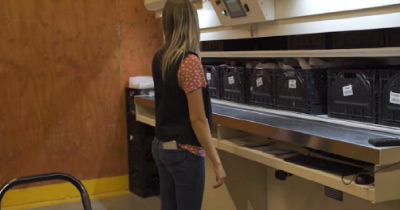A vertical carousel is a high-density storage solution that operates on the vertical axis.
The mechanism that drives a vertical carousel is similar to the mechanism that drives a Ferris wheel; however, rather than rotating on a circular path, as a Ferris wheel would, the shelving units move up and down vertically, following an elongated oval path.
This configuration means that vertical carousels can more than double the storage capacity of ordinary static shelving units.

In addition, vertical carousels can significantly improve warehouse performance. That’s because a vertical carousel’s internal mechanism is integrated with computer software, creating a true “goods-to-person” delivery system.
When a certain product needs to be picked, it is the software that directs the carousel to present the correct tote to the operator at the work counter. This accelerates pick speed, improves picking accuracy, and enhances workplace ergonomics.
Automated storage solutions offer many advantages vs. static shelving
Traditionally, most warehouse inventory has been stored on static shelving systems consisting of pullout drawers, wire racks, or pallet racking. Because the dimensions on static systems are fixed, they cannot optimize warehouse space.
Other more advanced storage solutions—whether they are vertical or horizontal carousels or vertical lift modules (VLMs)—can store items more densely than static shelving. These automated systems are all “goods-to-person” solutions because they utilize an operator based in a centralized location, and the goods move to the operator, rather than the operator moving to the goods.
Benefits of Vertical Carousel
Vertical carousels use automation to direct a pathway of standard shelves inside a single storage unit. Vertical carousels are ideal for storage of items in totes or of similar heights.
Vertical Carousel benefits include:
- Improved flexibility and efficiency in picking and fulfillment
- Fast ROI – companies can often recover their investment in less than 12 months
- Reduced labor – save up to two-thirds of previously required man-hours
- Optional totes, bins, and drawers for small and large components increase storage flexibility
- Easy integration – interface with WMS, ERP, and ERP systems
